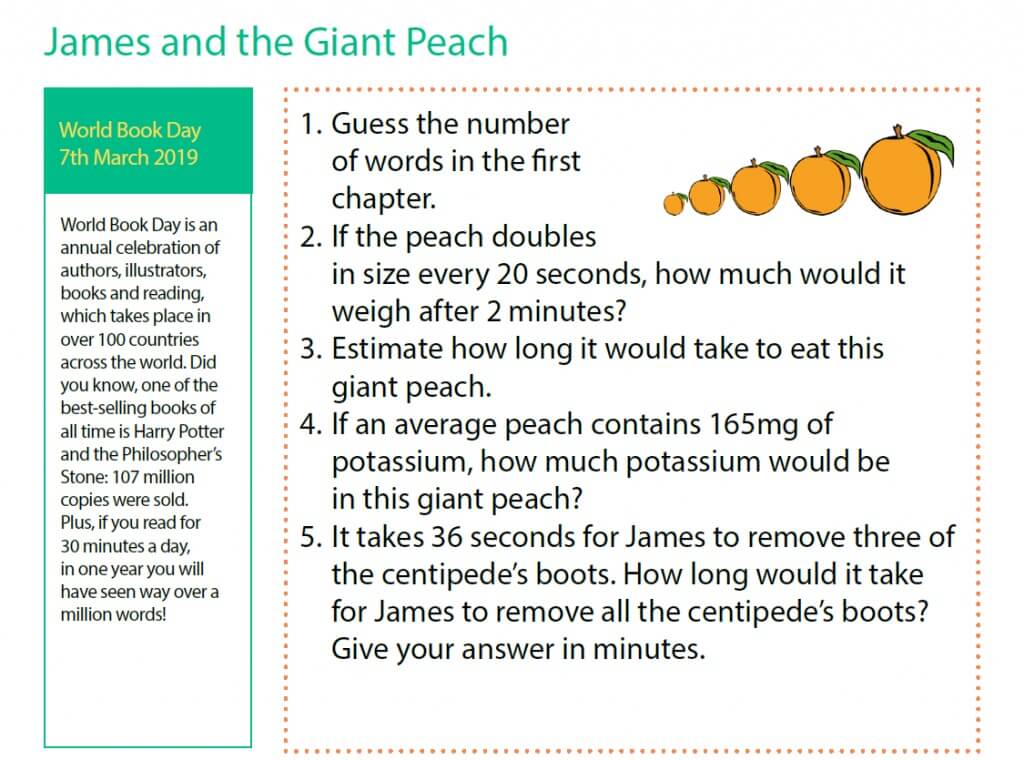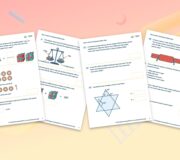World Book Day Maths Activities 2025
Try these free World Book Day Maths activities with your KS2 class in 2025, the best way to make developing Maths reasoning skills fun!
The beginning of March means many things. Mostly, it’s a chance to try out some great World Book Day Maths activities. For many schools, this is a unique and truly exciting time; pupils in particular appreciate the opportunity to dress up and even teachers aren’t entirely immune to the exciting prospect of donning the garb of their favourite character.
World Book Day can reveal how pupils – and oftimes even misguided adults – may see Maths and English as two insular topics, polarised and never meeting. But, as any good teacher knows, this is never the case. Indeed it couldn’t be further from the truth and is in some instances a damaging view.
In 2025, World Book Day will take place on Thursday 6th March.
This article is part of our series of KS2 maths problem solving investigations based on real life events in primary school. Others include Easter maths activities and Christmas maths activities.
KS2 Topical Maths Problems For Dates This Term
25 Maths investigations linked to calendar dates, designed to develop reasoning and problem solving in your pupils
Download Free Now!Maths is linked to literacy
Young learners of all ages need to be aware that knowledge is flexible, interchangeable and that, in the real world, a malleable approach to learning will benefit them hugely. For Maths in particular, World Book Day presents the perfect opportunity to do that.
As teachers we must remember that while content is what we teach, we must also focus on how we teach it. Do we teach Maths in isolation or as a part of something larger and more fulfilling? Maths is never so insular as when it’s taught in the classroom and contextual and topical problem solving is a way to circumnavigate this.
Third Space Learning’s online maths one-to-one lessons try to incorporate real world maths problems, showing students how maths appears in everyday life.

Contextual Maths is not a new idea for KS2 lessons
Nor are its benefits unloaded, in article for The Guardian, Conrad Wolfram argued that pupils ‘should be grappling with real problems and applying maths to them’, suggesting that if this did not happen maths would remain ‘so despised in education’ despite how ‘powerful and important’ it is in real life.
Topical maths – particularly topics like World Book Day – allows you to link primary school learning to ‘real problems’ and to what have become hugely important elements of the education system in Britain.

Meet Skye, the voice-based AI tutor making maths success possible for every student.
Built by teachers and maths experts, Skye uses the same pedagogy, curriculum and lesson structure as our traditional tutoring.
But, with more flexibility and a lower cost, schools can scale online maths tutoring to support every student who needs it.
Watch Skye in actionLiteracy across the curriculum
Consider the fact that tests are becoming more difficult in their wording, and pupils are increasingly being expected to have a higher level of literacy in subjects that do not necessarily depend on it in order to reach their potential in tests.
Do you want to avoid that moment where a pupil is capable of doing the Maths, but simply cannot understand the phrasing of the question? Use days like this to bring an element of literacy into your Maths lesson.
With all this in mind, here are our favourite World Book Day based Maths activities for you to use in your classroom this week. Get reading!
World Book Day Maths Activities You Can Do Right Now!
The materials for some super maths activities are in your classroom already. That’s right – look to the back of the room, now left (or right). The book corner!
Dust off those dust jackets and straighten those spines – it’s time to breathe some life back into those dog-eared pages. Here are some activities you could take part in with your class on World Book Day:
- Book measurements – You could measure the length, width and even depth of the books in your shelves.
Is the book with the largest front cover area also the book with the greatest volume? (If there are some picture books lurking in your shelves… unlikely.) - Give each table group a shelf – Count how many books fit on each group’s shelf. You could then calculate the mean average books per shelf. How many more books does the shelf with the most books hold than the shelf with the least books? (You could also get the children to arrange the books by the majority colour of the front cover – and then get them to put them back into the shelves accordingly… colour-coordinated reading corner… life hack!)
- Word counts – You could get children to estimate, then count the number of words on the first page of the book that they’ve selected from the bookshelf. You could demonstrate an estimation strategy – counting the number of words on a line, multiplying that amount by the number of lines of page 1.
(Make it a competition – the pupil who estimates closest to the actual number of words wins… a book – yep, engagement in Maths out of the Literacy Co-ordinator’s budget… winning!)
Now it is time to delve into some of the classic books that all classrooms have just sitting on the shelf and use them to learn some maths!
World Book Day Maths Activity 1

James and the Giant Peach
Ask pupils to read the first chapter of James and the Giant Peach, then get them to answer the questions below:
- Guess the number of words in the first chapter
- It takes 34 seconds for James to remove three of the centipede’s boots. How long would it take for James to remove all the centipede’s boots? Give your answer in minutes.
World Book Day Maths Activity 2

A World Full of Words
Have a look at this extract from The Lion, The Witch and The Wardrobe:
“Lucy felt a little frightened, but she felt very inquisitive and excited as well. She looked back over her shoulder and there, between the dark tree trunks; she could still see the open doorway of the wardrobe and even catch a glimpse of the empty room from which she had set out. (She had, of course, left the door open, for she knew that it is a very silly thing to shut oneself into a wardrobe.)
It seemed to be still daylight there. “I can always get back if anything goes wrong,” thought Lucy. She began to walk forward, crunch-crunch over the snow and through the wood towards the other light. In about ten minutes she reached it and found it was a lamp-post.
As she stood looking at it, wondering why there was a lamp-post in the middle of a wood and wondering what to do next, she heard a pitter patter of feet coming towards her. And soon after that a very strange person stepped out from among the trees into the light of the lamp-post.
Now complete the investigations below:
- Investigate how many of each letter of the alphabet there is in the extract.
- Choose your favourite part of your favourite book and do the same. Make sure the extract has 178 words ‘to make your investigation fair and equal. What are the similarities/differences? What are the most popular letters/least popular letters.
- Look into other details such as different types of punctuation and different word classes.
More problem solving and reasoning articles
DO YOU HAVE STUDENTS WHO NEED MORE SUPPORT IN MATHS?
Skye – our AI maths tutor built by teachers – gives students personalised one-to-one lessons that address learning gaps and build confidence.
Since 2013 we’ve taught over 2 million hours of maths lessons to more than 170,000 students to help them become fluent, able mathematicians.
Explore our AI maths tutoring or find out about primary school tuition for your school.







